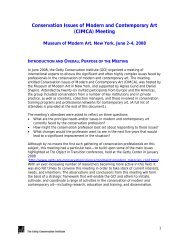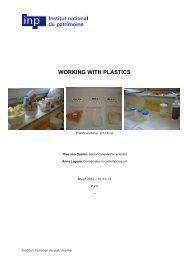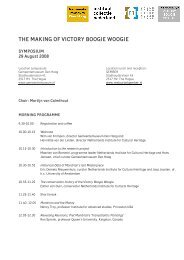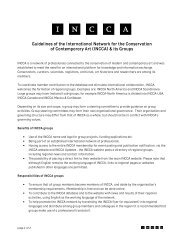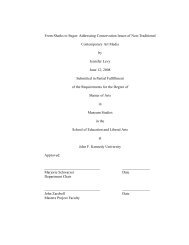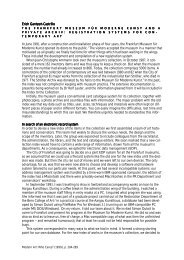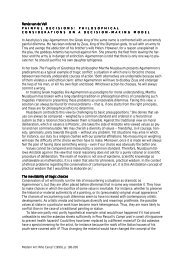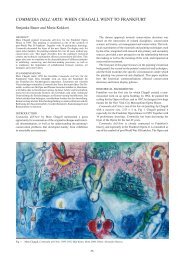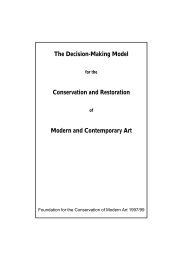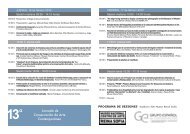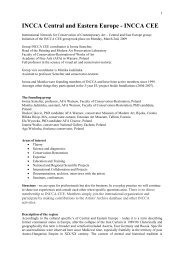VAN DE WETERING, E. Conservation-Restoration Ethics and ... - incca
VAN DE WETERING, E. Conservation-Restoration Ethics and ... - incca
VAN DE WETERING, E. Conservation-Restoration Ethics and ... - incca
Create successful ePaper yourself
Turn your PDF publications into a flip-book with our unique Google optimized e-Paper software.
impact. In that situation, the conservator-restorer deals primarily with the visual impact of the work<br />
according to the artist’s real or presumed wishes. He or she participates in a performance that is<br />
rather theatrical than museal in the traditional sense.<br />
But: the theatre is the place where lies create truth – interventions are taken which in the view of<br />
conservation-restoration ethics are heavyh<strong>and</strong>ed <strong>and</strong> highly unethical – radical repairs including<br />
complete reconstructions or, in the case of paintings, overpaintings. Such interventions may be<br />
carried out for the sake of the moment <strong>and</strong> may imply a serious loss of authenticity of the object as<br />
a source about itself <strong>and</strong> its maker.<br />
Thus in the field of contemporary art the conservator-restorer is torn between two forces: the<br />
existential power of the work as a statement in the present <strong>and</strong> his or her awareness that the object<br />
at some point, probably very soon, will be absorbed into the stream of time, becoming an historical<br />
object as well <strong>and</strong> deserving the utmost care as a source about its original appearance, own meaning<br />
<strong>and</strong> function for future generations.<br />
Differ<br />
ferent ent speeds of transfor<br />
forma<br />
mation<br />
Apart from the anthropological <strong>and</strong> restoration ethics anchored in a conservator-restorer’s role to<br />
preserve the past for the future, <strong>and</strong> the existential involvement of the artist to make a strong statement,<br />
there is thus a third aspect involved – the inevitability of the object’s transformation over<br />
time. This transformation does not only involve the ageing <strong>and</strong> changing of the material but especially<br />
takes place in the minds of the beholders. As to this last type of transformation, Br<strong>and</strong>i noted<br />
in his Teoria del Restauro that the object is constantly reborn in the minds of those who see it <strong>and</strong><br />
that it is undergoing a multitude of transformations in the process.<br />
For the conservator-restorer it is important to be aware of this phenomenon. To someone, for<br />
instance, who has known the artist or was once an assistant in his/her studio or helped in the presentation<br />
of the object, the speed of transformation is much slower than for the young conservatorrestorer<br />
of a later generation. The first category of conservators tends to prolong the present, in an<br />
effort to support the strength <strong>and</strong> actuality of the artist’s statement. For the young conservator, the<br />
same artist <strong>and</strong> the same object may be already history, with all the consequences this may entail<br />
for the care of the object as a source about the past <strong>and</strong> the sense of responsibility for its transition<br />
to the future. In this situation, the autonomy of conservation-restoration ethics already takes over<br />
for younger conservator-restorers while for older ones the present <strong>and</strong> the ‘theatrical’ function of<br />
the object prevails.<br />
The transformation of a work of art is tragic. Who would not like to prolong its ‘here <strong>and</strong> nowness’?<br />
No doubt, like other aspects of human life, the existential forces at first have priority over<br />
prudence <strong>and</strong> conservative forces. But, like in the existential situation of humankind, the transition<br />
of present into past is inevitable. And behind existential forces such as the lack of fear for risks, in a<br />
present situation there is also the natural inclination to care <strong>and</strong> the need to prolong life. It is then<br />
the classical ethics of conservation takes over even before the object’s existential power as part of<br />
the (prolonged) present has faded.<br />
Of course, given the transitoriness of many objects of contemporary art, the task to preserve<br />
is almost impossible. However, unless transitoriness is an integral <strong>and</strong> explicit part of the<br />
artist’s statement, one should not be resigned to these objects decaying, believing that a proper<br />
documentation would suffice to maintain the memory of an object. Documentation is always<br />
biased. One should rather stick to the adage that conservation-restoration does not mean doing the<br />
possible, but that it should mean doing the impossible. The classical ethics of restoration may then<br />
be the force behind the development of technical innovation which, as so often happened in the<br />
past, would make seemingly impossible acts of preservation possible.<br />
Ernst van de Wetering is professor of art history at the University of Amsterdam<br />
Modern Art: Who Cares? (1999), p. 247-249.



